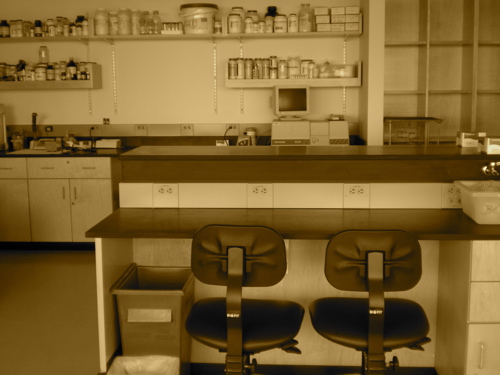Difference between revisions of "20.109(S10):Amplify aptamer-encoding DNA (Day1)"
(→Protocols) |
(→Introduction) |
||
| Line 12: | Line 12: | ||
+1 more paragraph general background on aptamers and/or heme</font color> | +1 more paragraph general background on aptamers and/or heme</font color> | ||
| + | |||
| + | Based on the numerous applications of PCR, it may seem that the technique has been around forever. In fact it is only 25 years old. In 1984, Kary Mullis described this technique for amplifying DNA of known or unknown sequence, realizing immediately the significance of his insight. | ||
| + | |||
| + | [[Image:Be109karymullis.jpg|thumb|left|150px|'''Kary Mullis''']] | ||
| + | |||
| + | ''"Dear Thor!," I exclaimed. I had solved the most annoying problems in DNA chemistry in a single lightening bolt. Abundance and distinction. With two oligonucleotides, DNA polymerase, and the four nucleosidetriphosphates I could make as much of a DNA sequence as I wanted and I could make it on a fragment of a specific size that I could distinguish easily. Somehow, I thought, it had to be an illusion. Otherwise it would change DNA chemistry forever. Otherwise it would make me famous. It was too easy. Someone else would have done it and I would surely have heard of it. We would be doing it all the time. What was I failing to see? "Jennifer, wake up. I've thought of something incredible." '' --Kary Mullis from his Nobel lecture; December 8, 1983 | ||
| + | |||
| + | <br style="clear:both;"/> | ||
==Protocols== | ==Protocols== | ||
Revision as of 17:38, 5 January 2010
Contents
Introduction
Back when he was a postdoctoral fellow, Professor Niles screened a random library of RNA aptamers to find one that binds to heme – the iron-containing site in hemoglobin. It is known that heme can bind to certain transcription factors and modulate gene expression, and RNA aptamers are one potential tool for learning more about signaling networks involving heme. (Niles 13, 14) To select heme-binding aptamers, Professor Niles ran a pool of RNAs with 50 randomized base pairs through a heme affinity column. He then amplified the post-column pool of aptamers and repeated the process several times. An aptamer called “6-5” survived through the 6th round of screening, but ultimately was found not to bind to heme. An aptamer called “8-12” survived through all 8 rounds of screening, and has a heme binding affinity of 220 nM (Niles).
Today you will be given two archival plasmids containing the 6-5 and 8-12 sequences, respectively. RNA is not very stable compared to DNA; thus, RNA aptamers are copied into their associated DNA sequences for long-term storage. Placing the DNA fragment into a plasmid that can be carried in bacteria provides further amplification and storage capabilities. We will make use of these capabilities more extensively in Module 2.
In order to select and amplify just the short DNA fragment that encodes for the aptamer, you will use the polymerase chain reaction, PCR. PCR comprises three main steps: 1) template DNA containing a desired sequence is melted, 2) primers anneal to specific locations on the now melted (i.e., single-stranded) DNA, and 3) the primers are extended by a polymerase to select and create the desired product. Extension occurs at ~70 °C, melting at ~95°C, and annealing at a temperature ~5 °C below the primer melting temperature; thus, the repetition of these steps is called thermal cycling. After each cycle, the newly formed products themselves become templates, causing exponential amplification of the selected sequence. (Note that the early rounds of PCR will not produce the desired product - we will see why in today's pre-lab lecture.)
Once the PCR is running, you will… Make gel, or at least initial mixing? Primer design or analysis exercise, e.g., how long will product be given primers and seq?)
+1 more paragraph general background on aptamers and/or heme
Based on the numerous applications of PCR, it may seem that the technique has been around forever. In fact it is only 25 years old. In 1984, Kary Mullis described this technique for amplifying DNA of known or unknown sequence, realizing immediately the significance of his insight.
"Dear Thor!," I exclaimed. I had solved the most annoying problems in DNA chemistry in a single lightening bolt. Abundance and distinction. With two oligonucleotides, DNA polymerase, and the four nucleosidetriphosphates I could make as much of a DNA sequence as I wanted and I could make it on a fragment of a specific size that I could distinguish easily. Somehow, I thought, it had to be an illusion. Otherwise it would change DNA chemistry forever. Otherwise it would make me famous. It was too easy. Someone else would have done it and I would surely have heard of it. We would be doing it all the time. What was I failing to see? "Jennifer, wake up. I've thought of something incredible." --Kary Mullis from his Nobel lecture; December 8, 1983
Protocols
Part 1: Amplify DNA fragment encoding aptamer
- You will be given plasmids encoding the DNA for two aptamers: “6-5” (at X μg/mL) and “8-12” (at X μg/mL). Make a plan for adding 2 ng of DNA to each PCR reaction, in no more than 20 μL final volume of plasmid and water.
- Per reaction, add 20 μL of Master Mix, 5 μL of each primer, the DNA template, and water to a total of 50 μL.
- The PCR will run for about 1 hour, on the following cycle:
| Segment | Cycles | Temperature (° C) | Time |
|---|---|---|---|
| 1 | 1 | 94 | 4 min |
| 2-4 | 25 | 94 | 30 sec |
| 57 | 30 sec | ||
| 72 | 30 sec | ||
| 5 | 1 | 72 | 10 min |
| 6 | 1 | 4 | indefinite |

